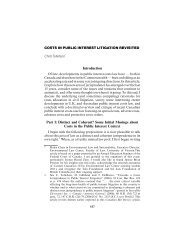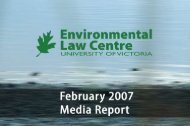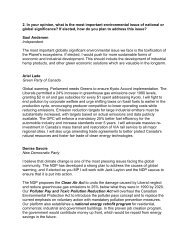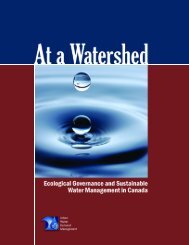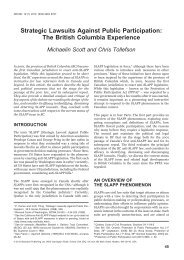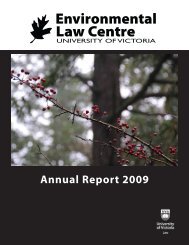Peeling back the Pavement - POLIS Water Sustainability Project
Peeling back the Pavement - POLIS Water Sustainability Project
Peeling back the Pavement - POLIS Water Sustainability Project
You also want an ePaper? Increase the reach of your titles
YUMPU automatically turns print PDFs into web optimized ePapers that Google loves.
fur<strong>the</strong>r loss or degradation of “beneficial uses” in <strong>the</strong> watershed. This change mirrors a<br />
similar move in Australia towards a more integrated “watershed perspective.”<br />
South Australia’s Stormwater Management Authority<br />
The Stormwater Management Authority (SMA) is a relatively new independent statutory<br />
body created under <strong>the</strong> Local Government Act in <strong>the</strong> State of South Australia.<br />
Established in 2007, <strong>the</strong> Local Government Stormwater Management Amendment Act<br />
sets out <strong>the</strong> joint roles and responsibilities of <strong>the</strong> State and local governments within<br />
<strong>the</strong> state and provides governance arrangements for stormwater management on a<br />
watershed basis throughout South Australia.<br />
Local councils continue to play a major role in stormwater management under <strong>the</strong><br />
SMA, including preparing stormwater management plans and oversight of infrastructure<br />
projects, with <strong>the</strong> Authority facilitating <strong>the</strong> coordination of stormwater issues<br />
between councils that share <strong>the</strong> same watershed. The act also commits approximately<br />
Can$4 million per year (indexed) for 30 years by <strong>the</strong> State for local governments to<br />
carry out stormwater planning, community education, pilot projects, and catalyze green<br />
infrastructure projects through a Stormwater Management Fund. Parliament, Natural<br />
Resource Management Board, and local government disaster funds support <strong>the</strong> fund.<br />
One of <strong>the</strong> SMA’s early actions was to establish a set of guidelines including six policy<br />
goals for comprehensive stormwater management planning. A principle objective of<br />
<strong>the</strong>se goals is to define <strong>the</strong> responsibility of <strong>the</strong> SMA (ra<strong>the</strong>r than individual councils) to<br />
coordinate planning for stormwater management on a watershed basis.<br />
• Apply risk management framework for hazards/flooding based on catchment<br />
characteristics and rigorous data collection;<br />
• Facilitate more productive use of stormwater;<br />
• Manage <strong>the</strong> environmental impacts of stormwater as a conveyor of pollution;<br />
• Manage stormwater as part of <strong>the</strong> urban water cycle recognizing natural<br />
watercourses and ecosystems where feasible;<br />
• Achieve responsible stormwater management locally by making better use of <strong>the</strong><br />
statutory development planning system; and<br />
• Gain innovative stormwater policy outcomes through <strong>the</strong> most effective funding<br />
and procurement arrangements.<br />
Local councils that want funding support for stormwater infrastructure through <strong>the</strong><br />
SMA's Stormwater Management Fund must first develop a Stormwater Management<br />
Plan (SMP) that conforms to <strong>the</strong>se six guidelines. These plans must be developed in<br />
consultation with <strong>the</strong> community. As outlined in South Australia’s water plan, <strong>Water</strong><br />
for Good, SMPs also need to explore <strong>the</strong> harvesting and reuse aspects of stormwater<br />
management. Ultimately, both <strong>the</strong> Natural Resources Management Board and <strong>the</strong> SMA<br />
must approve plans. Eventually, all future investment in stormwater infrastructure with<br />
state government support (i.e. beyond <strong>the</strong> SMA’s Stormwater Management Fund) will<br />
be in infrastructure that has been justified through <strong>the</strong> SMP process. In South Australia,<br />
this is creating a strong incentive for ongoing innovation and a positive cycle of progressive<br />
infrastructure development. Sources on page 67.<br />
55



